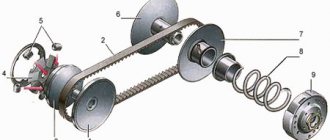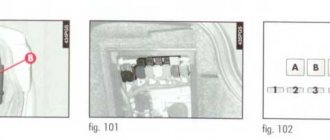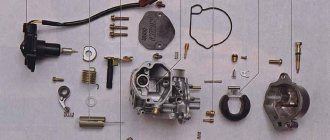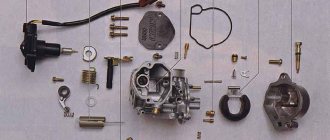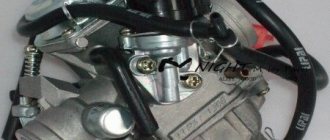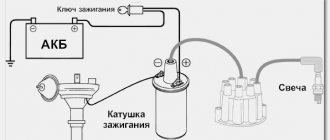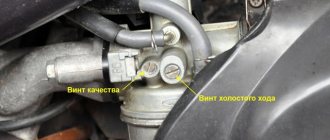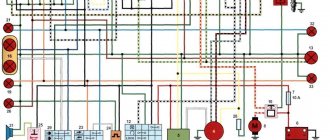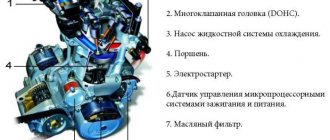All scooters fail sooner or later. Of course, you can try to find information about the malfunction on the Internet, purchase equipment and spare parts, and repair your vehicle yourself. However, this is too costly both in terms of time and finances. It is best to contact professionals who will quickly and efficiently repair your scooter, in particular its CVT. By the way, not many motor vehicle owners know what a variator on a scooter is and why it is needed. Read more about this spare part below.
What is a scooter's CVT?
A CVT on a scooter is like a gearbox in a car. This part is an important component of a motorcycle engine, which is used in the transmission. A variator on a scooter is needed in order to set the required speed limit while the vehicle is moving.
There are two types of variators:
- front;
- rear
There are also cast and composite variators. Engineers have developed many types of designs for these parts, but V-belt variators are most often used in scooters.
How does a scooter's CVT work?
Since the V-belt variator is the most commonly used design that is installed on a scooter, the design of this type of variator will be described below.
The scooter's CVT is designed in such a way as to provide an automatic continuously variable transmission. A scooter's variator consists of drive and driven pulleys and a V-belt. The cross-section of the belt has the shape of a trapezoid. The drive pulley is a small cone-shaped part that has two halves (cheeks). One cheek is motionless. It is screwed to the journal (tail) of the crankshaft with a bolt and washer. The second cheek of the pulley rests on special rollers and moves along the shaft with their help. The rollers, in turn, rest against the stationary cheek of the drive pulley. The driven pulley has the same structure as the driving one. However, instead of rollers, a spring is installed on it.
A scooter's variator, the design of which may differ slightly in different models of motor vehicles, is much simpler than a standard manual or automatic transmission. Its replacement and repair will cost much less than classic manual and automatic transmissions. In addition, when driving a scooter with a variator, the driver practically does not participate in changing gears, since the operation of the variator depends on the number of revolutions of the engine itself.
Advantages of manual transmission over automatic transmission
Quite often, Mitsubishi Lancer X car owners have a desire to change the automatic transmission in their car to a manual one. There are several explanations for this phenomenon:
- a manual gearbox is more reliable and breaks down less during operation;
- the use of a manual transmission improves the dynamic characteristics of the car (by spinning the engine to the required speed and shifting gears at the right moment);
- with proper driving with a manual transmission, you can reduce fuel consumption by almost a quarter than when driving with a CVT/automatic;
- the mechanics are free of such disadvantages as long gear selection or early switching;
- A manual transmission is cheaper to maintain (especially compared to CVT or robotic gearboxes).
How does a scooter's CVT work?
To understand the principle of operation of a scooter's variator, you need to imagine a system for changing gear ratios in a regular bicycle: sprockets at the front and rear, and a chain between them. The role of sprockets in a scooter's variator is played by pulleys (driver and driven), and the role of the chain is played by a trapezoidal belt. The pulley cheeks can move closer and further away from each other, due to which the position of the variator belt changes. The closer the pulley cheeks, the closer the belt is to the axis of the pulleys (inside), the further away, the closer the belt is to the outer edge of the pulleys (outside). If the belt is very close to the axis of the pulleys, the radius along which it moves is small. The radius of movement of the belt is also called the working radius of the variator.
A variator on a scooter, the operating principle of which is quite simple, operates according to the following mechanism: if the working radii of both pulleys are the same, they rotate at the same speed; if you rotate a pulley with a larger working radius faster, then a pulley with a smaller working radius will also rotate faster.
As engine speed increases (as vehicle speed increases), the drive pulley compresses and the driven pulley moves apart. This leads to the fact that the gear ratio changes. It is worth noting that the radii of both pulleys always change synchronously.
In order for the scooter to work properly and speeds to switch smoothly, it is necessary to properly configure the variator. This can be done manually or using special tools. In order to adjust the scooter's variator, it is best to contact an experienced technician. He will not only adjust the gear mechanism, but also perform a preventive inspection and repair of the entire transmission. Proper operation of the variator and transmission will not only extend the life of the scooter, but also prevent a possible accident.
The design and principle of operation of a scooter variator
What is a variator? A CVT is a mechanical continuously variable transmission. It is used to smoothly change the rotation speed of the driven shaft. Basically, all types of scooters have a V-belt variator. It consists of a drive pulley, a driven and a V-belt and works only depending on the number of engine revolutions, without reacting to loads (for example, when going uphill, the load on the rear wheel increases, but the gear ratio remains unchanged), which is one of its disadvantages .
Let's start with the simplest. Why V-belt? From the picture on the left you can see that the belt in section has a trapezoidal shape and is “wedged” into the pulley only with its side surfaces. When these surfaces wear, due to their shape, it cuts deeper into the pulley and still remains in good adhesion to it.
How does the gear ratio change? The design of the drive pulley (the drive pulley is rotated by the crankshaft) is such that its cheeks, when exposed to centrifugal forces, smoothly compress and push the V-belt further and further from the center of the pulley. The driven pulley, on the contrary, unclenches, and the belt on it smoothly sinks closer and closer to the center of the pulley. The higher the engine speed, the more the drive pulley compresses and the driven pulley expands, thereby changing the gear ratio from the crankshaft to the rear wheel. This process is clearly visible in these figures:
The engine is not running.
Low engine speed.
Average engine speed.
Maximum engine speed.
The figures also show the positions of the V-belt in a section on the drive pulley (left) and driven pulley (right) under different engine operating modes.
How is the drive centrifugal pulley of the variator arranged? Quite simple!
Let's look at its design, shown in the figure:
Drive centrifugal pulley of the variator.
1 - fixed pulley cheek, rigidly screwed to the trunnion (tail) of the crankshaft 5 with a bolt 8 with washer 6. V-belt 2 is placed between cheeks 1 and 3. Cheek 3 is designed so that it moves freely on shaft 5. It is moved by rollers 4 that rest into the persistent and stationary cheek 9. Under the influence of centrifugal force, the rollers 4 diverge from the center of the shaft 5, thereby moving the cheek 3 closer to the cheek 1 and pushing the belt 2 further from the shaft 5. The positions of the rollers 4 and cheeks 3 at different engine speeds you already seen in the four pictures above.
Now a little about the driven pulley (picture below).
Driven pulley.
It differs from the drive pulley in that it does not have rollers, but instead a spring (see picture on the right). At the moment when the cheeks on the driving pulley come together, pushing out the belt, on the driven pulley the cheeks (namely, the cheek 5 moves along the shaft 7, the cheek 6 is installed rigidly and motionless), on the contrary, they diverge, compressing the spring 3, and the belt drops deeper, which again, it can be seen in the engine operating modes above in four figures. Thanks to spring 3, the V-belt is always tensioned, and its tension increases proportionally with increasing speed. This in turn allows the belt to not slip at higher speeds, at which the load is greater than at lower speeds.
There are also simpler models of scooters that do not have a variator on the drive shaft. Instead, a simple pulley is installed and the gear ratio from it to the driven one is fixed at all engine speeds. Such models exceed 50 km/h. do not develop and “stupidly” gain momentum from a standstill. Their driven pulley is the same as that of CVTs - under a spring and serves only to tension the belt. The only advantage of this device is that the belt lasts longer.
Then the automatic clutch, which is assembled with the driven pulley, comes into operation.
Good luck!
Source: www.moto.com.ua
CVT components
The scooter has a small weight and dimensions (compared to motorcycles and cars), respectively, and the gearbox should be small.
From the automobile, the scooter's variator inherited:
- two pulleys - driving and driven (although here they are wedge-shaped, and each consists of two halves);
- belt (its shape is trapezoidal, unlike a car belt).
That's all the legacy.
The position of the wedge-shaped halves (cheeks) of the drive pulley is regulated by rollers. The opening and closing of the driven pulley cheeks is carried out by a central spring connected to the clutch.
More about the operating principle
So... The scooter is started and idling. What happens in the variator? The drive pulley rotates at minimum speed. The strap is located just above the center of the cheeks. The slave's cheeks are compressed by a central spring. The belt on them moves along the maximum radius.
The scooter started moving. It's worth mentioning the videos here. They are located behind the inner cheek of the drive pulley. When the speed of rotation of this pulley increases, centrifugal force pushes the rollers towards the outer radius, thereby pressing the halves of the drive pulley together. The belt between these halves moves outward - the radius of its rotation on the leading cheeks increases.
The driven pulley acts exactly the opposite. During acceleration, a centrifugal force acts on it, just like on the rollers, with the help of which the cheeks move apart, compressing the central spring and passing the belt between them. This is how acceleration happens.
Due to this synchronous operation of the pulleys, speed increases at constant speed and maximum engine power.
What is the optimal weight for rollers?
And so, let’s repeat the principle of operation of rollers for a scooter’s variator. When the crankshaft rotates, the rollers diverge by a certain amount. The higher the speed of the power unit and the rotation of the crankshaft, the greater this value. This means the belt extends more and the scooter starts faster. The two-stroke power unit on a scooter is characterized by operating at maximum speed. For the most part, scooter rollers cope with this task.
Quite heavy rollers accompany belt extension at low speeds. At the same time, a drop in dynamics is observed. But, at the same time, the maximum speed is achieved. The operating principle of light rollers is the opposite. That is, the productive element works to its maximum in order to gain maximum speed. Dynamic qualities are reduced back. At the start, the speed will increase quite quickly, but up to 30 km/h. After that, it will be more and more difficult to gain speed.
Based on this, we can draw the following conclusion. The weight of the rollers should be average, optimal. It should be borne in mind that the speed of a moped does not always depend on the weight of the rollers. A significant influence is exerted by the current drive spring - a large spring that is located behind the clutch. What is it for? – responsible for belt fatigue and tension. When it is weakened, the belt is ejected to a larger radius. Thus, with normal weight of the rollers, it is difficult to reach the maximum speed. Often, in such situations, the spring is replaced.
First you need to try rollers half a gram lighter than indicated in the instructions. Experienced scooter riders always have rollers of various weights in “steps” of 0.5-1 grams. The optimal rollers are determined by trial and error. It is difficult and practically impossible to indicate which rollers to install on a scooter without “experiments”. After all, each scooter may have a different condition of the CPG, belt and spring, and variator. One thing can be said for sure, without any doubt: it is impossible to install rollers of different weights in one set. This leads to an imbalance in the operation of the crankshaft and the rapid replacement of its bearings.
Setting up a variator on a scooter
By adjusting the variator, the desired dynamics of the scooter are achieved. It can be improved by replacing both the factory rollers and the spring.
The operation of the rollers on a scooter's variator depends on their weight. The manufacturer selects the optimal one when assembling the box. But those who like to drive fast change them to heavier ones. With weighted rollers, a scooter with a variator accelerates more slowly at the start, but after reaching maximum speed, the engine produces a speed 10-15 km/h higher than with factory rollers.
Using rollers of less weight leads to the opposite principle: the scooter starts sharply, but it is difficult for it to reach maximum speed.
Changing spring stiffness also affects speed. Stretched and weak, it will not be able to tightly press the cheeks of the driven pulley. This will cause the belt to constantly operate at a smaller radius than necessary. A spring that is too stiff, on the contrary, will not allow you to reduce this radius (correspondingly increase the speed of the driven pulley) and develop the maximum speed of the scooter.
ProVariator.RU
Polygonal variator rollers. How to put it correctly? Video
Video review of polygonal variator rollers from the online store Scooter.rv.ua
Polygonal variator rollers appeared relatively recently in Ukraine, although they have been used abroad for a very long time and in full swing. The main task of polygonal rollers is to operate the transmission of your scooter. This is to add a little dynamics, a little speed (if your variator and the condition of the belt allow this), and also increase the mileage from replacement to replacement of rollers. There are two cones on the polygonal rollers: one large and the second small, so, correctly, the rollers are installed like this: with a large cone towards the variator hub, but so that the cone is at the top and not at the bottom, and with a small cone, respectively, towards the outer part. Watch the video for more details.
Repair of a variator on a scooter. Replacing elements
A change in acceleration speed and the appearance of extraneous noise in the variator indicate that some part (or parts) are worn out and require replacement.
To find out the cause of the malfunction, you should disassemble the variator:
- Remove the cover. We do this carefully so as not to damage it. As a rule, the variator cover on scooters has a sealing gasket. It is necessary to evaluate its condition and, if necessary, change it.
- To remove the belt from the variator, you need to remove the drive pulley. And you can get to it only by removing the retaining ring, clutch and gear.
- When the belt and pulley halves are ready, remove the rollers.
- All items must be carefully inspected and tested. Serviceable cheeks have a smooth surface without chips or burrs. The presence of any lubricants on the belt is excluded. If it looks shabby, then it's time to change it.
- After identifying faults, we assemble the variator in the reverse order.
There are two main signs by which the quality of the variator is determined: belt movement and engine speed. In a working variator, the belt does not slip in the pulleys. But, if the engine roars and the scooter does not move, this is the first signal that it is time to look inside the device and examine the condition of the belt and spring.
The operating speed of the engine must correspond to the speed of its maximum power. If this does not happen, it’s time to start adjusting the operation of the variator.
What is the optimal weight for rollers?
And so, let’s repeat the principle of operation of rollers for a scooter’s variator. When the crankshaft rotates, the rollers diverge by a certain amount. The higher the speed of the power unit and the rotation of the crankshaft, the greater this value. This means the belt extends more and the scooter starts faster. The two-stroke power unit on a scooter is characterized by operating at maximum speed. For the most part, scooter rollers cope with this task.
Quite heavy rollers accompany belt extension at low speeds. At the same time, a drop in dynamics is observed. But, at the same time, the maximum speed is achieved. The operating principle of light rollers is the opposite. That is, the productive element works to its maximum in order to gain maximum speed. Dynamic qualities are reduced back. At the start, the speed will increase quite quickly, but up to 30 km/h. After that, it will be more and more difficult to gain speed.
Based on this, we can draw the following conclusion. The weight of the rollers should be average, optimal. It should be borne in mind that the speed of a moped does not always depend on the weight of the rollers. A significant influence is exerted by the current drive spring - a large spring that is located behind the clutch. What is it for? – responsible for belt fatigue and tension. When it is weakened, the belt is ejected to a larger radius. Thus, with normal weight of the rollers, it is difficult to reach the maximum speed. Often, in such situations, the spring is replaced.
First you need to try rollers half a gram lighter than indicated in the instructions. Experienced scooter riders always have rollers of various weights in “steps” of 0.5-1 grams. The optimal rollers are determined by trial and error. It is difficult and practically impossible to indicate which rollers to install on a scooter without “experiments”. After all, each scooter may have a different condition of the CPG, belt and spring, and variator. One thing can be said for sure, without any doubt: it is impossible to install rollers of different weights in one set. This leads to an imbalance in the operation of the crankshaft and the rapid replacement of its bearings.
